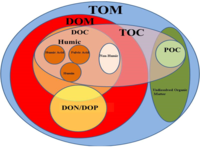
Photo from wikipedia
The denitrification process profoundly affects soil nitrogen (N) availability and generates its byproduct, nitrous oxide, as a potent greenhouse gas. There are large uncertainties in predicting global denitrification because its… Click to show full abstract
The denitrification process profoundly affects soil nitrogen (N) availability and generates its byproduct, nitrous oxide, as a potent greenhouse gas. There are large uncertainties in predicting global denitrification because its controlling factors remain elusive. In this study, we compiled 4301 observations of denitrification rates across a variety of terrestrial ecosystems from 214 papers published in the literature. The averaged denitrification rate was 3516.3 ± 91.1 µg N kg−1 soil day−1. The highest denitrification rate was 4242.3 ± 152.3 µg N kg−1 soil day−1 under humid subtropical climates, and the lowest was 965.8 ± 150.4 µg N kg−1 under dry climates. The denitrification rate increased with temperature, precipitation, soil carbon and N contents, as well as microbial biomass carbon and N, but decreased with soil clay contents. The variables related to soil N contents (e.g., nitrate, ammonium, and total N) explained the variation of denitrification more than climatic and edaphic variables (e.g., mean annual temperature (MAT), soil moisture, soil pH, and clay content) according to structural equation models. Soil microbial biomass carbon, which was influenced by soil nitrate, ammonium, and total N, also strongly influenced denitrification at a global scale. Collectively, soil N contents, microbial biomass, pH, texture, moisture, and MAT accounted for 60% of the variation in global denitrification rates. The findings suggest that soil N contents and microbial biomass are strong predictors of denitrification at the global scale.
Journal Title: Global Change Biology
Year Published: 2021
Link to full text (if available)
Share on Social Media: Sign Up to like & get
recommendations!